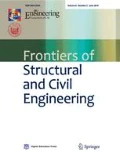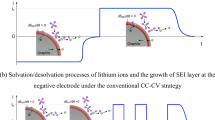Abstract
The stress evolution, total charging time and capacity utilization of pulse charging (PC) method are investigated in this paper. It is found that compared to the conventional constant current (CC) charging method, the PC method can accelerate the charging process but will inevitably cause an increase in stress and a decrease in capacity. The charging speed for PC method can be estimated by the mean current. By introducing stress control, a modified PC method called the PCCC method, which starts with a PC operation followed by a CC operation, is proposed. The PCCC method not only can accelerate charging process but also can avoid the stress raising and capacity loss occurring in the PC method. Furthermore, the optimal pulsed current density and switch time in the PCCC method is also discussed.
Similar content being viewed by others
References
Anseán D, González M, Viera J C, García V M, Blanco C, Valledor M. Fast charging technique for high power lithium iron phosphate batteries: a cycle life analysis. Journal of Power Sources, 2013, 239: 9–15
Wang D, Wu X, Wang Z, Chen L. Cracking causing cyclic instability of LiFePO4 cathode material. Journal of Power Sources, 2005, 140(1): 125–128
Vetter J, Novák P, Wagner M R, Veit C, Möller K C, Besenhard J O, Winter M, Wohlfahrt-Mehrens M, Vogler C, Hammouche A. Ageing mechanisms in lithium-ion batteries. Journal of Power Sources, 2005, 147(1–2): 269–281
Schmidt A P, Bitzer M, Imre Á W, Guzzella L. Model-based distinction and quantification of capacity loss and rate capability fade in Li-ion batteries. Journal of Power Sources, 2010, 195(22): 7634–7638
Li J, Murphy E, Winnick J, Kohl P A. The effects of pulse charging on cycling characteristics of commercial lithium-ion batteries. Journal of Power Sources, 2001, 102(1–2): 302–309
de Jongh P E, Notten P H L. Effect of current pulses on lithium intercalation batteries. Solid State Ionics, 2002, 148(3–4): 259–268
Purushothaman B K, Landau U. Rapid charging of lithium-ion batteries using pulsed currents: a theoretical analysis. Journal of the Electrochemical Society, 2006, 153(3): A533–A542
Savoye F, Venet P, Millet M, Groot J. Impact of periodic current pulses on Li-ion battery performance. IEEE Transactions on Industrial Electronics, 2012, 59(9): 3481–3488
Beh H Z Z, Covic G A, Boys J T. Effects of pulse and DC charging on lithium iron phosphate (LiFePO4) batteries. In: IEEE Energy Conversion Congress and Exposition. Denver: IEEE, 2013, 315–320
Purushothaman B K, Morrison P W Jr, Landau U. Reducing masstransport limitations by application of special pulsed current modes. Journal of the Electrochemical Society, 2005, 152(4): J33–J39
Keil P, Jossen A. Charging protocols for lithium-ion batteries and their impact on cycle life—An experimental study with different 18650 high-power cells. Journal of Energy Storage, 2016, 6: 125–141
Song Y, Shao X, Guo Z, Zhang J. Role of material properties and mechanical constraint on stress-assisted diffusion in plate electrodes of lithium ion batteries. Journal of Physics. D, Applied Physics, 2013, 46(10): 105307
Zhang X, Shyy W, Marie Sastry A. Numerical simulation of intercalation-induced stress in li-ion battery electrode particles. Journal of the Electrochemical Society, 2007, 154(10): A910–A916
Taheri P, Hsieh S, Bahrami M. Investigating electrical contact resistance losses in lithium-ion battery assemblies for hybrid and electric vehicles. Journal of Power Sources, 2011, 196(15): 6525–6533
Lu B, Song Y, Zhang Q, Pan J, Cheng Y T, Zhang J. Voltage hysteresis of lithium ion batteries caused by mechanical stress. Physical Chemistry Chemical Physics, 2016, 18(6): 4721–4727
Bucci G, Swamy T, Bishop S, Sheldon BW, Chiang Y M, Carter W C. The effect of stress on battery-electrode capacity. Journal of the Electrochemical Society, 2017, 164(4): A645–A654
Deshpande R, Verbrugge M, Cheng Y T, Wang J, Liu P. Battery cycle life prediction with coupled chemical degradation and fatigue mechanics. Journal of the Electrochemical Society, 2012, 159(10): A1730–A1738
Xu J, Deshpande R D, Pan J, Cheng Y T, Battaglia V S. Electrode side reactions, capacity loss and mechanical degradation in lithiumion batteries. Journal of the Electrochemical Society, 2015, 162(10): A2026–A2035
Barai P, Smith K, Chen C F, Kim G H, Mukherjee P P. Reduced order modeling of mechanical degradation induced performance decay in lithium-ion battery porous electrodes. Journal of the Electrochemical Society, 2015, 162(9): A1751–A1771
Cheng Y T, Verbrugge M W. Evolution of stress within a spherical insertion electrode particle under potentiostatic and galvanostatic operation. Journal of Power Sources, 2009, 190(2): 453–460
Zhang J, Lu B, Song Y, Ji X. Diffusion induced stress in layered Liion battery electrode plates. Journal of Power Sources, 2012, 209: 220–227
Lu B, Song Y, Zhang J. Selection of charge methods for lithium ion batteries by considering diffusion induced stress and charge time. Journal of Power Sources, 2016, 320: 104–110
Crank J. The Mathematics of Diffusion. Oxford University Press, 1979
Zhang S, Zhao K, Zhu T, Li J. Electrochemomechanical degradation of high-capacity battery electrode materials. Progress in Materials Science, 2017, 89: 479–521
Lu B, Song Y, Guo Z, Zhang J. Modeling of progressive delamination in a thin film driven by diffusion-induced stresses. International Journal of Solids and Structures, 2013, 50(14–15): 2495–2507
Lu B, Zhao Y, Song Y, Zhang J. Analytical model on lithiationinduced interfacial debonding of an active layer from a rigid substrate. Journal of Applied Mechanics, 2016, 83(12): 121009
Hu S, Liang Z, He X. Hybrid sinusoidal-pulse charging method for the Li-ion batteries in electric vehicle applications based on AC impedance analysis. Journal of Power Electronics, 2016, 16(1): 268–276
Vo T T, Chen X, Shen W, Kapoor A. New charging strategy for lithium-ion batteries based on the integration of Taguchi method and state of charge estimation. Journal of Power Sources, 2015, 273: 413–422
Qi Y, Hector L G Jr, James C, Kim K J. Lithium concentration dependent elastic properties of battery electrode materials from first principles calculations. Journal of the Electrochemical Society, 2014, 161(11): F3010–F3018
Hasan M F, Chen C F, Shaffer C E, Mukherjee P P. Analysis of the implications of rapid charging on lithium-ion battery performance. Journal of the Electrochemical Society, 2015, 162(7): A1382–A1395
Shirazi A H N, Mohebbi F, Kakavand M R A, He B, Rabczuk T. Paraffin nanocomposites for heat management of lithium-ion batteries: a computational investigation. Journal of Nanomaterials, 2016, 2016: 2131946
Mortazavi B, Yang H, Mohebbi F, Cuniberti G, Rabczuk T. Graphene or h-BN paraffin composite structures for the thermal management of Li-ion batteries: a multiscale investigation. Applied Energy, 2017, 202: 323–334
Safari M, Morcrette M, Teyssot A, Delacourt C. Life-prediction methods for lithium-ion batteries derived from a fatigue approach I. Introduction: capacity-loss prediction based on damage accumulation. Journal of the Electrochemical Society, 2010, 157(6): A713–A720
Safari M, Morcrette M, Teyssot A, Delacourt C. Life prediction methods for lithium-ion batteries derived from a fatigue approach II. Capacity-loss prediction of batteries subjected to complex current profiles. Journal of the Electrochemical Society, 2010, 157(7): A892–A898
Acknowledgements
This project was supported by the National Natural Science Foundation of China (Grant Nos. 11702166, 11332005, and 11702164), the Shanghai Municipal Education Commission (No. 13ZZ070), the Shanghai Sailing Program (No. 17YF1606000) and the Science and Technology Commission of Shanghai Municipality (No. 14DZ2261200).
Author information
Authors and Affiliations
Corresponding author
Rights and permissions
About this article
Cite this article
Zhao, Y., Lu, B., Song, Y. et al. A modified pulse charging method for lithium-ion batteries by considering stress evolution, charging time and capacity utilization. Front. Struct. Civ. Eng. 13, 294–302 (2019). https://doi.org/10.1007/s11709-018-0460-z
Received:
Accepted:
Published:
Issue Date:
DOI: https://doi.org/10.1007/s11709-018-0460-z




